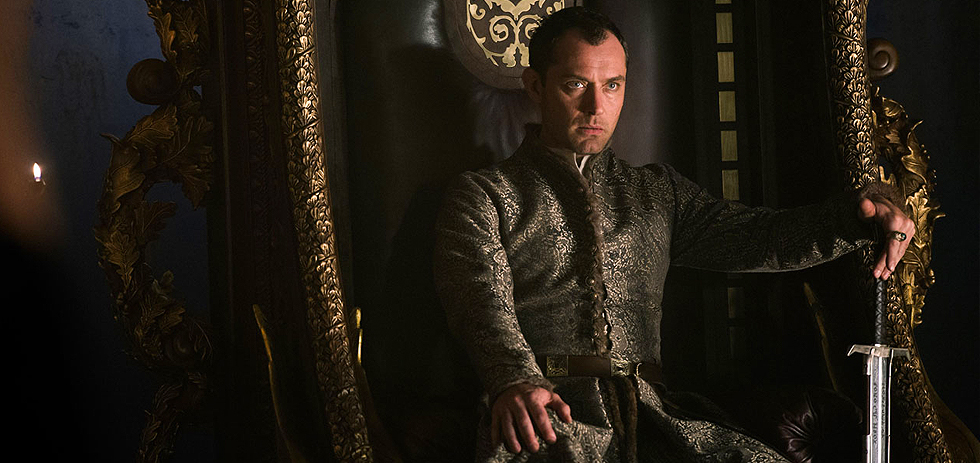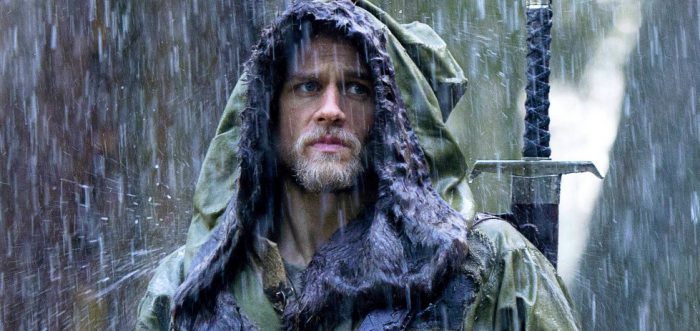
It’s been 13 years since Antoine Fuqua’s King Arthur, the last big-budget adaption of the Arthurian legend that reimagined its hero as a Roman officer fighting with Celts against Saxons. The differences between that film and Guy Ritchie’s King Arthur: Legend of the Sword are emblematic of the changes Hollywood has undergone in that time — from revisionist historical drama to over-the-top, VFX-driven fantasy franchise starter. Both films cherry pick recognisable names and mix them into a new narrative. Neither one is any good.
Ritchie’s story begins with the betrayal of good king Uther Pendragon (Eric Bana) by his ambitious and mildly magical brother Vortigern (Jude Law), leaving Uther’s son Arthur (Charlie Hunnam) to float like Moses to Londinium — where he’s promptly adopted by a brothel, learns how to hustle and (in trademark Ritchie style) becomes a small-time gangster who looks after his lads and his girls. He also learns how to fight from a Kung-Fu master — named George — who, for reasons never fully established, keeps giving the young Arthur money. When Arthur pisses off the wrong vikings, he’s rounded up with other men of his age to try and pull Excalibur from the stone, as part of Vortigern’s plan to find and kill the lost king. Arthur succeeds, and is lined up for a public execution — only to be rescued by a group of rebels led by Sir Bedivere (Djimon Hounsou) and Goosefat Bill (Aidan Gillen), and dragged into fulfilling his destiny with the help of Astrid Bergès-Frisbey’s The Mage1. Despite sounding suspiciously like a condensed version of all four Hunger Games films, this first act is the strongest; if there’s anyone who could turn King Arthur into a fast-talking street urchin, it’s Ritchie, and there’s a self-indulgence to Vortigern’s monologues that only Jude Law could pull off.
About an hour into the film things start to get incomprehensible: Arthur must travel to The Dark Lands — either a metaphorical internal journey or a trip to an actual alternate dimension; the film never clarifies — and fight a bunch of bats, snakes and giant rats all at once, or maybe not at all. It’s revealed that most of Vortigern’s power comes from a tower he’s building at Camelot that mirrors a Mage Tower in the Dark Lands, meaning there’s a plot line about disrupting the supply of building materials so his tower can’t get any taller. When Arthur has both hands on his sword, he can manipulate time, which he does in a couple of speed ramp slow-mo fight scenes straight out of the Zack Snyder playbook. The fights and chase scenes similarly make little sense, and the final showdown between Arthur and Vortigern is both dull and difficult to follow — relying on colour cues that are lost in the murky palate of the Dark Lands, and a muscly CGI stand-in that presumably meant Jude Law could go home early. By the end, it’s hard to keep track of what’s happening, and even harder to care.

The film borrows heavily from more successful franchises, most obviously The Lord Of the Rings — there’s a glowing blue sword, giant battle elephants, a malevolent tower with a fiery penthouse of evil, and a king who has lost his throne and must regain it (with said glowing blue sword). Arthur also evokes the Stone Table from Narnia, the lost baby king in a boat and rounding up of young men from the Bible, and the R.O.U.S.es from The Princess Bride. The one source the film seems determined to steer clear of is Arthurian legend itself: there’s no Guinevere, no Lancelot, and only a brief appearance of the Round Table (and nothing you’d recognise from Monty Python and The Holy Grail.) This version of Arthur is closer to Robin Hood, hiding in the forest with his band of rebels and looking out for the little guy. Ritchie’s Sherlock Holmes kept close to Conan Doyle’s version of the character, despite its steampunk aesthetic, while The Man from U.N.C.L.E was so far from cultural relevance that the filmmaker was basically able to do whatever he wanted — and it’s the latter approach he’s applied to King Arthur. 2
Inconsistency is King Arthur’s biggest flaw. While there are enjoyable moments, especially the comic story-telling riffs and street-level hustling that Ritchie cut his teeth on, they’re scattered in between by-the-numbers battle sequences and chases involving so much shaky cam you’re left wondering how a $175-million film didn’t manage to find a line in the budget for tripods 3 Arthur switches between verbose, almost Shakespearean prose and Cockney vernacular, while Eric Bana’s accent fluctuates amusingly in his few scenes between regal and ocker. Ritchie’s intentions are similarly all over the place: the film goes to great pains to break Arthur down into a regular guy, a street hustler from London, only to put a sword in his hand and make him the medieval equivalent of Quicksilver.
Hunnam is as wooden here as he was in Pacific Rim, although he isn’t helped by the uneven script. Jude Law chews scenery and delivers a solid performance when the script allows him to, but too often he is a theoretical antagonist rather than a present threat It’s worth noting that the film paints Hunnam, at 37, as the young upstart to his “ageing” tyrannical uncle — 44-year-old Law. Bergès-Frisbey has an accent, which makes her “mysterious” and “other-worldly,” and Hounsou and Gillen are reliable, but the rest of the cast are so ill-defined and jumbled together it’s hard to pick out any one character. Unsurprisingly, there are few women — mostly noblewomen and prostitutes4 — and roughly half of them are killed on screen.
If there’s a word other than inconsistent for King Arthur: Legend of the Sword, it’s unnecessary — in another year crowded with unwanted sequels, remakes and reboots, this uneven, unimaginative take on a character we’ve seen before only adds to the noise.
